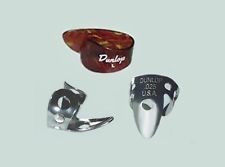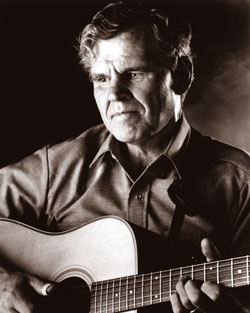Doc Watson Guitar Chords
Although not a blues guitar player in the strictest sense, Doc Watson's finger picking technique calls for special attention.
The relaxed sounds of this very popular Doc Watson Guitar Lesson - Deep River Blues and the intricacy of Doc's finger style creates a formidable item of guitar playing which is tough to re-produce. It is this complex, easy feel which possibly leads to a lot of teachers to over simplify Doc's method, or worse, make it too complex utilizing two or several fingers of the picking hand.
In actual fact, Doc picks with simply his thumb and one finger of his right hand to create this impressive feeling - let's take a look at how he does it.
I hope you like the guitar lesson! There are a couple of wonderful videos
on Youtube of Doc Watson performing Deep River Blues.
Never mind the fact that Doc didn't write Deep River ( it was published and sung by the Delmore Brothers, a Country singing partnership, who recorded it as 'I've Got The Big River') Doc undoubtedly made it his own.
Doc's Right Hand Picking Technique
Re-working the song in a Travis picking way introduced delicate
complexities, and yet produced a really relaxed feel. Many acoustic
guitarists have a variation of Deep in their list of songs, and I perform this song routinely in public.
However, not many of us perform it in really the same way as Doc.
Mostly, this is due the dexterity required. A lot of guitarists try to
accommodate the complex picking technique ( as they see it ) by using
two or more fingers on the right hand.
Other individuals over-simplify the approach, which is a bit of a
shame. In reality, Doc's approach on Deep River IS simple, but it's the
sheer dexterity that floors us.
The resulting sound can be
impressive, but doesn't really reflect accurately what Doc does.
Did Doc Use One Picking Finger Or More?
Doc simply plays with one finger on his right hand. As you can imagine, this one finger (his first) moves fairly quickly and the thumb also moves across to assist with the syncopation now and again. The use of just one finger was the primary factor which struck me concerning Doc's picking technique.
 It reminded me of the ragtime blues guitar of Reverend Gary Davis,
who additionally used one right hand finger. 'One is all you need', he
is noted to have said!
It reminded me of the ragtime blues guitar of Reverend Gary Davis,
who additionally used one right hand finger. 'One is all you need', he
is noted to have said!
Like Watson, the Reverend's picking hand thumb
may leap across to the treble strings. Each guitarist's thumb and
finger acted quite independently, with the thumb often breaking out of
the set alternating bass form to create single string runs or
syncopated off-beats.
The embedded online video beneath
features a complete 15 minute guitar lesson for Deep River Blues. It was initially
posted as 2 lessons.
The first portion examines the one finger process
and the basic picking structure, leading on to approaches that we might
use to approximate Doc's sound, in case we can't manage to play
exactly as he does! (This in all probability means most of us!)
The 2nd part will take a glimpse into the 'fiddly bits' in Watson's picking style. This is where Doc's thumb produces some fascinating sounds by moving out of it's bass pattern. We look at a break and also end-tag variations.
Of course, Doc Watson's flat picking is legendary, and I'm not sure when he came to fingerpicking, but it was probably under the influence of the music made by Merle Travis, whose skill was so unique that the style of using that alternating bass thumb pattern became known as 'Travis picking'.
It's a bit harsh, as there were many fantastic pickers using the exact same patterns all over the States decades before - men like Blind Blake, Mississippi John Hurt, Blind Boy Fuller and of course Rev Gary Davis.
Other site pages covering the alternating bass picking patterns of the old blues men:
The curious thing is that a select few of the guitarists using just their thumb and forefinger created some sounds that seemed far more complex than players using more than one finger. In fact, a common failing of modern guitar players is to over-complicate the techniques.
When I use two fingers, I find that the music tends to speed up, so often use one finger to keep down the pace. Deep River Blues in Doc's style is quite leisurely paced, and he really takes his time with the delivery.
Fingerstyle guitarists who use just the thumb and forefinger need to be very inventive to create the same kind of syncopation as similar artists using two or more fingers. The first question is - What is syncopation?
First of all, we could describe syncopation in strictly musical terms, but I suspect it doesn't mean a lot to most musicians or hobby fingerpickers. Let's face it, most people want to learn how to play like Doc Watson and don't necessarily need to understand the technical reasons for why it sounds just great!
In musical terms, syncopation in music is achieved by placing the accent on the off beat rather than the first beat. This is unusual to the ear and when done properly (as in the case of Scott Joplin and his piano rags), it can be very appealing - it's difficult to stop your feet from tapping!
A more accessible definition is to say that syncopation is a change in tempo or rhythm that pleasantly surprises the audience. I like this definition.
The change in rhythm, or melody variations, are not expected but please the ear when they do. That all very well for a piano player who has 88 keys at his disposal, but how does a guitar player create these complex sounds and add syncopation to his music?
You would think that as many fingers as possible should be used to pick the guitar strings, because of the complexity required, and in some cases modern guitarists do use all of their fingers, just like classical musicians and flamenco players.
Looking at the Deep River Blues tab will give you some idea where the fingers should go, but no amount of guitar tabs will show you how to play with that Watson rhythm. When you hear Watson playing there's an overall impression of perfect timing, which only comes from years of practice. Listen to songs like Beaumont Rag, and others, to get a feel for the Doc Watson style.
How To Play Travis Guitar In The Doc Watson Style
How To Play Guitar Using Finger Picks - Better Than Bare Fingers?
As with most things, finger picks have pros and cons.
Advantages of Finger Picks:
- They are a natural amplifier
- Produce a clear and sharp sound
- Fit more easily between the guitar strings
- Protect the fingers
 Strike any guitar string with a bare finger and then do the same thing wearing a stainless steel or plastic pick. The sound is much louder and generally lasts longer.
Strike any guitar string with a bare finger and then do the same thing wearing a stainless steel or plastic pick. The sound is much louder and generally lasts longer. This is because a hard surface (the pick edge) is striking the hard surface of the string. This can be a great advantage when recording for example, or playing in noisy bars.
As well as being louder, finger picks also produce a cutting sound that can be heard through traffic noise, or in other noisy places, so great for busking.
When combining picks with a naturally loud guitar such as a National Steel (à la Floyd Council) the loudness is dramatically increased.
Disadvantages Of Using Finger Picks
- They wear out the strings fast!
- Make too much noise
- Sounds Metallic
- You can lose them!
However, if you use relatively expensive coated strings and are used to changing your strings quite often, then it can become very expensive. For example, a professional player with 3 or 4 gigs per week, or someone playing on the streets every day might change the guitar strings once a week.
I speak from experience when I tell you - you will lose them! It's not a good idea to rely on one thing, whatever it is you do, so if you cannot play without picks, if you mislay them you are totally screwed.
In my own case, just once I had to go on stage to play with bare finger because I lost my finger picks. Another time, a thumb pick broke and I hadn't bothered to buy spares the day before, so be warned.
In quiet situations, they can be just too damn harsh and metallic sounding. If you're playing a delicate folk or blues ballad, the hard sound of pick meeting string can be hard to control and be totally out of place. In this case, or when recording in the studio, bare fingers might be best.


